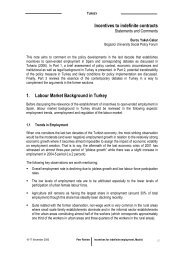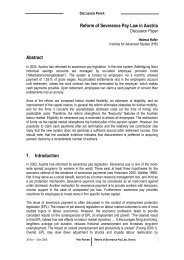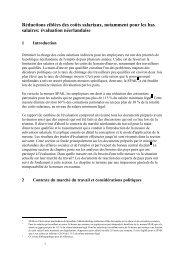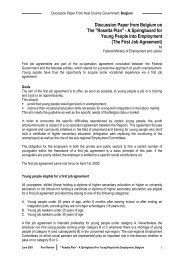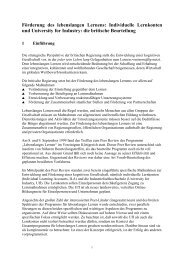Comprehensive strategies for active ageing - mutual learning ...
Comprehensive strategies for active ageing - mutual learning ...
Comprehensive strategies for active ageing - mutual learning ...
Create successful ePaper yourself
Turn your PDF publications into a flip-book with our unique Google optimized e-Paper software.
SUMMARY<br />
Active <strong>ageing</strong> is not an issue that affects older workers in isolation but all members of society and a wide range<br />
of policy fields. Odile Quintin stressed that to age <strong>active</strong>ly you have to start young!<br />
Maarten Camps agreed with the points made by Odile Quintin in her opening statement and expressed the wish<br />
<strong>for</strong> concrete examples policies to attract and maintain people in the labour market. He argued that the evidence<br />
suggests that a range of incentives, <strong>for</strong> employers to maintain older workers in the work<strong>for</strong>ce and <strong>for</strong> employees<br />
to remain in work, could be effective and that it was there<strong>for</strong>e important to discuss and disseminate these.<br />
3. Thematic Expert Paper<br />
“Incentives to take up work and remain in work longer” – Jaap de Koning<br />
The Implications of the <strong>ageing</strong> process on the labour market<br />
Jaap de Koning’s paper focused on the implications <strong>for</strong> the labour market of demographic <strong>ageing</strong>. He outlined<br />
the possible impacts of the <strong>ageing</strong> process on the relative size of the work<strong>for</strong>ce, on participation rates and on<br />
productivity and innovation. He then looked at the role of incentives to keep older people in work, and at the<br />
challenges posed by <strong>ageing</strong> and policy responses to them.<br />
The impacts of the <strong>ageing</strong> process on the relative size of the population of working age between now and 2050<br />
are: a huge increase in the old age dependency ratio (i.e. the number of people over 65 divided by the number<br />
of people of working age); a rise in the share of the very old (80+); and a decrease in the share of young people.<br />
The latter may reduce pressure on the dependency ratio in countries with extremely low birth rates (e.g. some of<br />
the new member states), but accelerate the effects of <strong>ageing</strong> of the work<strong>for</strong>ce. These impacts will lead to an<br />
upward pressure on age-related public expenditure, a growth in the share of the <strong>active</strong> labour <strong>for</strong>ce needed <strong>for</strong><br />
care activities, negative effects on macro-economic productivity and higher tax rates (which may, in turn,<br />
generate a vicious circle reducing incentives to work and thereby pushing tax rates up even higher).<br />
Currently the participation rates of 50-65 year-olds in the work<strong>for</strong>ce are low (57.7% EU average in 2002). If one<br />
assumes that the current low labour market participation of this age category continues, the impacts of<br />
demographic <strong>ageing</strong> would be a drop of 10% in overall participation rates between 2000 and 2050 2 . The effect<br />
would be particularly acute <strong>for</strong> the countries of Central Europe. However, it is likely that the share of 50-65 yearolds<br />
in working age population will increase although the all-age participation rate will decline. Thus the overall<br />
impact of demographic <strong>ageing</strong> on participation rates will have a negative effect on the size of the labour <strong>for</strong>ce,<br />
and the level of employment, as well as macro-economic output and income.<br />
In terms of the impact of <strong>ageing</strong> on innovation and productivity, the existing evidence suggests that an older<br />
work<strong>for</strong>ce has negative effects on productivity and on innovation and productivity growth. However, the<br />
observed patterns may not be inevitable. Learning capacity stays intact if people continue to learn, older workers<br />
per<strong>for</strong>m equally well as younger workers in certain fields (which is an argument in favour of job mobility), and<br />
mobility and training throughout one's life positively affect per<strong>for</strong>mance later in life.<br />
Policy to date<br />
Incentives <strong>for</strong> employers to employ older workers are insufficient. The productivity-wage ratio is seen as<br />
unfavourable <strong>for</strong> these groups. Both younger and older workers appear to cost more than they produce whereas<br />
middle-aged workers produce more than they cost. Although there may be an 'implicit deal' between employers<br />
and employees regarding productivity-wage ratios over time, employers are unlikely to respect this if the<br />
government offers the option of using social benefit schemes as exit routes <strong>for</strong> older workers. In addition, older<br />
2 Burniaux, Duval and Jamotte (2004)<br />
20 April 2005 Thematic Review Seminar <strong>Comprehensive</strong> <strong>strategies</strong> <strong>for</strong> <strong>active</strong> <strong>ageing</strong><br />
2



